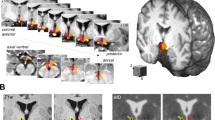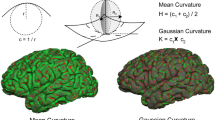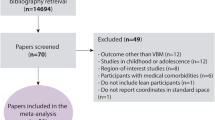Abstract
Although a variety of MRI studies investigated the link between body mass index (BMI) and parameters of neural gray matter (GM), the technique applied in most of these studies, voxel-based morphometry (VBM), focusses on the regional GM volume, a macroscopic tissue property. Thus, the studies were not able to exploit the BMI-related information contained in the GM microstructure although PET studies suggest that these factors are important. Here, we used cerebral MR Elastography (MRE) to characterize features of tissue microstructure by evaluating the propagation of shear waves applied to the skull and to assess local tissue viscoelasticity to test the link between this parameter and BMI in 22 lean to overweight males. Unlike the majority of existing MRE studies investigating neural viscoelasticity signals averaged across large brain regions, we used the viscoelasticity of individual voxels for our experiment. Our technique revealed a negative link between BMI and viscoelasticity of two areas of the striatal reward system, i.e., right putamen (t = −8.2; pFWE-corrected = 0.005) and left globus pallidus (t = −7.1; pFWE = 0.037) which was independent of GM volume at these coordinates. Finally, comparison of BMI models based on individual voxels vs. on signals averaged across brain atlas regions demonstrates that voxel-based models explain a significantly higher proportion of variance. Consequently, our findings show that cerebral MRE is suitable to identify medically relevant microstructural tissue properties. Using a voxel-wise analysis approach, we were able to utilize the high spatial resolution of MRE for mapping BMI-related information in the brain.




Similar content being viewed by others
References
Andersson, J. L. R., Skare, S., & Ashburner, J. (2003). How to correct susceptibility distortions in spin-echo echo-planar images: Application to diffusion tensor imaging. NeuroImage, 20, 870–888. https://doi.org/10.1016/S1053-8119(03)00336-7.
Arani, A., Murphy, M. C., Glaser, K. J., Manduca, A., Lake, D. S., Kruse, S. A., Jack, C. R., Jr., Ehman, R. L., & Huston, J., 3rd. (2015). Measuring the effects of aging and sex on regional brain stiffness with MR elastography in healthy older adults. NeuroImage, 111, 59–64. https://doi.org/10.1016/j.neuroimage.2015.02.016.
Barnhill, E., Hollis, L., Sack, I., Braun, J., Hoskins, P. R., Pankaj, P., Brown, C., van Beek, E. J. R., & Roberts, N. (2017). Nonlinear multiscale regularisation in MR elastography: Towards fine feature mapping. Medical Image Analysis, 35, 133–145. https://doi.org/10.1016/j.media.2016.05.012.
Berridge, K. C., Robinson, T. E., & Aldridge, J. W. (2009). Dissecting components of reward: “Liking”, “wanting”, and learning. Current Opinion in Pharmacology, 9, 65–73. https://doi.org/10.1016/j.coph.2008.12.014.
Braun, J., Guo, J., Lützkendorf, R., Stadler, J., Papazoglou, S., Hirsch, S., Sack, I., & Bernarding, J. (2014). High-resolution mechanical imaging of the human brain by three-dimensional multifrequency magnetic resonance elastography at 7T. NeuroImage, 90, 308–314. https://doi.org/10.1016/j.neuroimage.2013.12.032.
Bray, G. A. (2004). Medical consequences of obesity. The Journal of Clinical Endocrinology and Metabolism, 89, 2583–2589. https://doi.org/10.1210/jc.2004-0535.
Chaze, C. A., McIlvain, G., Smith, D. R., Villermaux, G. M., Delgorio, P. L., Wright, H. G., Rogers, K. J., Miller, F., Crenshaw, J. R., & Johnson, C. L. (2019). Altered brain tissue viscoelasticity in pediatric cerebral palsy measured by magnetic resonance elastography. NeuroImage Clinical, 22, 101750. https://doi.org/10.1016/j.nicl.2019.101750.
Christensen, R. (2011). Plane answers to complex questions: The theory of linear models. New York: Springer.
Cohen, J. (1988). Statistical power analysis for the behavioral sciences. Hillsdale, N.J: L. Erlbaum Associates.
Dittmann, F., Hirsch, S., Tzschätzsch, H., Guo, J., Braun, J., & Sack, I. (2015). In vivo wideband multifrequency MR elastography of the human brain and liver. Magnetic Resonance in Medicine, 76, 1116–1126. https://doi.org/10.1002/mrm.26006.
Fehlner, A., Papazoglou, S., McGarry, M. D., et al. (2015). Cerebral multifrequency MR elastography by remote excitation of intracranial shear waves. NMR in Biomedicine, 28, 1426–1432. https://doi.org/10.1002/nbm.3388.
Fehlner, A., Hirsch, S., Weygandt, M., Christophel, T., Barnhill, E., Kadobianskyi, M., Braun, J., Bernarding, J., Lützkendorf, R., Sack, I., & Hetzer, S. (2016). Increasing the spatial resolution and sensitivity of magnetic resonance elastography by correcting for subject motion and susceptibility-induced image distortions. Journal of Magnetic Resonance Imaging, 46, 134–141. https://doi.org/10.1002/jmri.25516.
Flegal, K. M., Kit, B. K., Orpana, H., & Graubard, B. I. (2013). Association of all-cause mortality with overweight and obesity using standard body mass index categories: A systematic review and meta-analysis. JAMA, 309, 71–82. https://doi.org/10.1001/jama.2012.113905.
Freimann, F. B., Müller, S., Streitberger, K.-J., Guo, J., Rot, S., Ghori, A., Vajkoczy, P., Reiter, R., Sack, I., & Braun, J. (2013). MR elastography in a murine stroke model reveals correlation of macroscopic viscoelastic properties of the brain with neuronal density. NMR in Biomedicine, 26, 1534–1539. https://doi.org/10.1002/nbm.2987.
Gerischer, L. M., Fehlner, A., Köbe, T., Prehn, K., Antonenko, D., Grittner, U., Braun, J., Sack, I., & Flöel, A. (2018). Combining viscoelasticity, diffusivity and volume of the hippocampus for the diagnosis of Alzheimer’s disease based on magnetic resonance imaging. NeuroImage Clinical, 18, 485–493. https://doi.org/10.1016/j.nicl.2017.12.023.
Guo, J., Hirsch, S., Fehlner, A., Papazoglou, S., Scheel, M., Braun, J., & Sack, I. (2013). Towards an elastographic atlas of brain anatomy. PLoS One, 8, e71807. https://doi.org/10.1371/journal.pone.0071807.
Hetzer, S., Birr, P., Fehlner, A., Hirsch, S., Dittmann, F., Barnhill, E., Braun, J., & Sack, I. (2017). Perfusion alters stiffness of deep gray matter. Journal of Cerebral Blood Flow & Metabolism, 38(1), 116–125. https://doi.org/10.1177/0271678X17691530.
Hetzer, S., Dittmann, F., Bormann, K., Hirsch, S., Lipp, A., Wang, D. J. J., Braun, J., & Sack, I. (2018). Hypercapnia increases brain viscoelasticity. Journal of Cerebral Blood Flow & Metabolism, 0271678X18799241. https://doi.org/10.1177/0271678X18799241.
Hirsch, S., Klatt, D., Freimann, F., Scheel, M., Braun, J., & Sack, I. (2013). In vivo measurement of volumetric strain in the human brain induced by arterial pulsation and harmonic waves. Magnetic Resonance in Medicine, 70, 671–683. https://doi.org/10.1002/mrm.24499.
Hirsch, S., Guo, J., Reiter, R., Papazoglou, S., Kroencke, T., Braun, J., & Sack, I. (2014). MR elastography of the liver and the spleen using a piezoelectric driver, single-shot wave-field acquisition, and multifrequency dual parameter reconstruction. Magnetic Resonance in Medicine, 71, 267–277. https://doi.org/10.1002/mrm.24674.
Hirsch, S., Braun, J., & Sack, I. (2017). Magnetic resonance Elastography: Physical background and medical applications. KGaA, Weinheim, Germany: Wiley-VCH Verlag GmbH & Co.
Hiscox, L. V., Johnson, C. L., McGarry, M. D. J., et al. (2018a). High-resolution magnetic resonance elastography reveals differences in subcortical gray matter viscoelasticity between young and healthy older adults. Neurobiology of Aging, 65, 158–167. https://doi.org/10.1016/j.neurobiolaging.2018.01.010.
Hiscox, L. V., Johnson, C. L., McGarry, M. D. J., et al. (2018b). Hippocampal viscoelasticity and episodic memory performance in healthy older adults examined with magnetic resonance elastography. Brain Imaging and Behavior. https://doi.org/10.1007/s11682-018-9988-8.
Ito, R., Everitt, B. J., & Robbins, T. W. (2005). The hippocampus and appetitive Pavlovian conditioning: Effects of excitotoxic hippocampal lesions on conditioned locomotor activity and autoshaping. Hippocampus, 15, 713–721. https://doi.org/10.1002/hipo.20094.
Janowitz, D., Wittfeld, K., Terock, J., Freyberger, H. J., Hegenscheid, K., Völzke, H., Habes, M., Hosten, N., Friedrich, N., Nauck, M., Domanska, G., & Grabe, H. J. (2015). Association between waist circumference and gray matter volume in 2344 individuals from two adult community-based samples. NeuroImage, 122, 149–157. https://doi.org/10.1016/j.neuroimage.2015.07.086.
Johnson, C. L., Schwarb, H., McGarry, M. D. J., Anderson, A. T., Huesmann, G. R., Sutton, B. P., & Cohen, N. J. (2016). Viscoelasticity of subcortical gray matter structures. Human Brain Mapping, 37, 4221-4233. https://doi.org/10.1002/hbm.23314.
Johnson, C. L., Schwarb, H., Horecka, K. M., McGarry, M. D. J., Hillman, C. H., Kramer, A. F., Cohen, N. J., & Barbey, A. K. (2018). Double dissociation of structure-function relationships in memory and fluid intelligence observed with magnetic resonance elastography. NeuroImage, 171, 99–106. https://doi.org/10.1016/j.neuroimage.2018.01.007.
Kishinevsky, F. I., Cox, J. E., Murdaugh, D. L., Stoeckel, L. E., Cook, E. W., III, & Weller, R. E. (2012). fMRI reactivity on a delay discounting task predicts weight gain in obese women. Appetite, 58, 582–592. https://doi.org/10.1016/j.appet.2011.11.029.
Kullmann, S., Callaghan, M. F., Heni, M., Weiskopf, N., Scheffler, K., Häring, H. U., Fritsche, A., Veit, R., & Preissl, H. (2016). Specific white matter tissue microstructure changes associated with obesity. NeuroImage, 125, 36–44. https://doi.org/10.1016/j.neuroimage.2015.10.006.
Lampe, L., Zhang, R., Beyer, F., Huhn, S., Kharabian-Masouleh, S., Preusser, S., Bazin, P. L., Schroeter, M. L., Villringer, A., & Witte, A. V. (2019). Visceral obesity relates to deep white matter hyperintensities via inflammation. Annals of Neurology, 85, 194–203. https://doi.org/10.1002/ana.25396.
Millward, J. M., Guo, J., Berndt, D., Braun, J., Sack, I., & Infante-Duarte, C. (2015). Tissue structure and inflammatory processes shape viscoelastic properties of the mouse brain. NMR in Biomedicine, 28, 831–839. https://doi.org/10.1002/nbm.3319.
Murphy, M. C., Manduca, A., Trzasko, J. D., Glaser, K. J., Huston, J., III, & Ehman, R. L. (2018). Artificial neural networks for stiffness estimation in magnetic resonance elastography. Magnetic Resonance in Medicine, 80, 351–360. https://doi.org/10.1002/mrm.27019.
Muthupillai, R., Lomas, D. J., Rossman, P. J., Greenleaf, J., Manduca, A., & Ehman, R. (1995). Magnetic resonance elastography by direct visualization of propagating acoustic strain waves. Science, 269, 1854–1857.
Ng, M., Fleming, T., Robinson, M., et al. (2014). Global, regional, and national prevalence of overweight and obesity in children and adults during 1980–2013: a systematic analysis for the Global Burden of Disease Study 2013. The Lancet, 384, 766–781. https://doi.org/10.1016/S0140-6736(14)60460-8.
O’Gorman, T. W. (2005). The performance of randomization tests that use permutations of independent variables. Communications in Statistics: Simulation and Computation, 34, 895–908. https://doi.org/10.1080/03610910500308230.
Pannacciulli, N., Del Parigi, A., Chen, K., et al. (2006). Brain abnormalities in human obesity: A voxel-based morphometric study. NeuroImage, 31, 1419–1425. https://doi.org/10.1016/j.neuroimage.2006.01.047.
Parpura, V., & Verkhratsky, A. (2012). Homeostatic function of astrocytes: Ca2+ and Na+ signalling. Translational Neuroscience, 3, 334–344. https://doi.org/10.2478/s13380-012-0040-y.
Patz, S., Fovargue, D., Schregel, K., Nazari, N., Palotai, M., Barbone, P. E., Fabry, B., Hammers, A., Holm, S., Kozerke, S., Nordsletten, D., & Sinkus, R. (2019). Imaging localized neuronal activity at fast time scales through biomechanics. Science Advances, 5, eaav3816. https://doi.org/10.1126/sciadv.aav3816.
Raji, C. A., Ho, A. J., Parikshak, N. N., Becker, J. T., Lopez, O. L., Kuller, L. H., Hua, X., Leow, A. D., Toga, A. W., & Thompson, P. M. (2010). Brain structure and obesity. Human Brain Mapping, 31, 353–364. https://doi.org/10.1002/hbm.20870.
Rothemund, Y., Preuschhof, C., Bohner, G., Bauknecht, H. C., Klingebiel, R., Flor, H., & Klapp, B. F. (2007). Differential activation of the dorsal striatum by high-calorie visual food stimuli in obese individuals. NeuroImage, 37, 410–421. https://doi.org/10.1016/j.neuroimage.2007.05.008.
Ryan, L., & Walther, K. (2014). White matter integrity in older females is altered by increased body fat. Obesity (Silver Spring), 22, 2039–2046. https://doi.org/10.1002/oby.20815.
Rypma, B., Fischer, H., Rieckmann, A., Hubbard, N. A., Nyberg, L., & Backman, L. (2015). Dopamine D1 binding potential predicts fusiform bold activity during face-recognition performance. Journal of Neuroscience: The Official Journal of the Society for Neuroscience, 35, 14702–14707. https://doi.org/10.1523/JNEUROSCI.1298-15.2015.
Sack, I., Beierbach, B., Wuerfel, J., Klatt, D., Hamhaber, U., Papazoglou, S., Martus, P., & Braun, J. (2009). The impact of aging and gender on brain viscoelasticity. NeuroImage, 46, 652–657. https://doi.org/10.1016/j.neuroimage.2009.02.040.
Sack, I., Jöhrens, K., Würfel, J., & Braun, J. (2013). Structure-sensitive elastography: On the viscoelastic powerlaw behavior of in vivo human tissue in health and disease. Soft Matter, 9, 5672–5680. https://doi.org/10.1039/C3SM50552A.
Schienkiewitz, A., Mensink, G. B. M., & Scheidt-Nave, C. (2012). Comorbidity of overweight and obesity in a nationally representative sample of German adults aged 18-79 years. BMC Public Health, 12, 658. https://doi.org/10.1186/1471-2458-12-658.
Schregel, K., Wuerfel, E., Garteiser, P., et al. (2012). Demyelination reduces brain parenchymal stiffness quantified in vivo by magnetic resonance elastography. Proceedings of the National Academy of Sciences of the United States of America, 109, 6650–6655. https://doi.org/10.1073/pnas.1200151109.
Schwarb, H., Johnson, C. L., McGarry, M. D. J., & Cohen, N. J. (2016). Medial temporal lobe viscoelasticity and relational memory performance. NeuroImage, 132, 534–541. https://doi.org/10.1016/j.neuroimage.2016.02.059.
Streitberger, K.-J., Reiss-Zimmermann, M., Freimann, F. B., Bayerl, S., Guo, J., Arlt, F., Wuerfel, J., Braun, J., Hoffmann, K. T., & Sack, I. (2014). High-resolution mechanical imaging of glioblastoma by multifrequency magnetic resonance elastography. PLoS One, 9, e110588. https://doi.org/10.1371/journal.pone.0110588.
Taki, Y., Kinomura, S., Sato, K., Inoue, K., Goto, R., Okada, K., Uchida, S., Kawashima, R., & Fukuda, H. (2008). Relationship between body mass index and gray matter volume in 1,428 healthy individuals. Obes Silver Spring Md, 16, 119–124. https://doi.org/10.1038/oby.2007.4.
Tzourio-Mazoyer, N., Landeau, B., Papathanassiou, D., Crivello, F., Etard, O., Delcroix, N., Mazoyer, B., & Joliot, M. (2002). Automated anatomical labeling of activations in SPM using a macroscopic anatomical parcellation of the MNI MRI single-subject brain. NeuroImage, 15, 273–289. https://doi.org/10.1006/nimg.2001.0978.
Volkow, N. D., Wise, R. A., & Baler, R. (2017). The dopamine motive system: Implications for drug and food addiction. Nature Reviews. Neuroscience, 18, 741–752. https://doi.org/10.1038/nrn.2017.130.
Wang, G. J., Volkow, N. D., Logan, J., Pappas, N. R., Wong, C. T., Zhu, W., Netusll, N., & Fowler, J. S. (2001). Brain dopamine and obesity. Lancet Lond Engl, 357, 354–357.
Weise, C. M., Piaggi, P., Reinhardt, M., Chen, K., Savage, C. R., Krakoff, J., & Pleger, B. (2017). The obese brain as a heritable phenotype: A combined morphometry and twin study. International Journal of Obesity 2005, 41, 458–466. https://doi.org/10.1038/ijo.2016.222.
Weygandt, M., Mai, K., Dommes, E., Leupelt, V., Hackmack, K., Kahnt, T., Rothemund, Y., Spranger, J., & Haynes, J. D. (2013). The role of neural impulse control mechanisms for dietary success in obesity. NeuroImage, 83, 669–678. https://doi.org/10.1016/j.neuroimage.2013.07.028.
Weygandt, M., Mai, K., Dommes, E., Ritter, K., Leupelt, V., Spranger, J., & Haynes, J. D. (2015). Impulse control in the dorsolateral prefrontal cortex counteracts post-diet weight regain in obesity. NeuroImage, 109, 318–327. https://doi.org/10.1016/j.neuroimage.2014.12.073.
Weygandt, M., Spranger, J., Leupelt, V., Maurer, L., Bobbert, T., Mai, K., & Haynes, J. D. (2019). Interactions between neural decision-making circuits predict long-term dietary treatment success in obesity. NeuroImage, 184, 520–534. https://doi.org/10.1016/j.neuroimage.2018.09.058.
Yokum, S., Ng, J., & Stice, E. (2012). Relation of regional gray and white matter volumes to current BMI and future increases in BMI: A prospective MRI study. International Journal of Obesity 2005, 36, 656–664. https://doi.org/10.1038/ijo.2011.175.
Acknowledgements
The authors would like to thank Patric Birr for his valuable help during data acquisition and Thomas Christophel for fruitful discussions.
Funding
IS and JB received funding from the European Union’s Horizon 2020 Programme (ID 668039, EU FORCE – Imaging the Force of Cancer) and from the German Research Foundation (grant no. Sa 901/16, GRK2260 BIOQIC, SFB1340 Matrix-in-Vision). MW received funding from the German Research Foundation (WE 5967/2-1).
Author information
Authors and Affiliations
Corresponding authors
Ethics declarations
Conflict of interest
The authors declare that they have no conflict of interest.
Ethical statement
The study was approved by the ethical review board of the Charité – Universitätsmedizin Berlin in conformity with the Declaration of Helsinki. All procedures performed in this study were in accordance with existing ethical standards. All authors have been personally and actively involved in substantial work leading to the manuscript.
Informed consent
Informed consent was obtained from all individual participants included in the study.
Additional information
Publisher’s note
Springer Nature remains neutral with regard to jurisdictional claims in published maps and institutional affiliations.
Rights and permissions
About this article
Cite this article
Hetzer, S., Hirsch, S., Braun, J. et al. Viscoelasticity of striatal brain areas reflects variations in body mass index of lean to overweight male adults. Brain Imaging and Behavior 14, 2477–2487 (2020). https://doi.org/10.1007/s11682-019-00200-w
Published:
Issue Date:
DOI: https://doi.org/10.1007/s11682-019-00200-w




